Thyroid Nodules: Symptoms And Causes
Thyroid nodules are often a cause for fear and concern, but in most cases they are benign. However, it is important to have a specialist diagnosis to confirm this. In today’s article, learn what causes this thyroid change and how it is diagnosed.

When thyroid nodules are called certain areas in the thyroid gland, where multiply or increase the cells of the organ and have swelling and adhesions result. Some lumps can be felt, but most of the time they are so small that you cannot feel them on your neck when you feel them.
Thyroid nodules can be solid or cystic in consistency. A cystic lump contains fluid and is encased in a capsule. However, solid nodes have a massive structure.
The nodes can appear in different areas of the thyroid gland, which consists of two main lobes connected by a narrow bridge of tissue. This butterfly-shaped organ is located at the front of the neck, under the larynx. Normally, the nodes cannot be scanned from the outside.
One of the tasks of the thyroid gland is to produce the hormones T3 and T4, so a node in this organ could be functional. This means that the node, like the rest of the tissue in the organ, secretes hormones. In this case, there are symptoms of an overactive thyroid.
Most thyroid nodules are benign, many are diagnosed only by chance when an examination of the organ is done for other reasons. Even so, there is a small percentage of nodules that can develop into a malignant tumor. That is why a thorough examination and diagnosis is very important.
Causes of thyroid nodules
The causes of lumps in the thyroid are very diverse. For example, a change in diet or local tumors in the neck area that spread to the thyroid could be responsible for this. We then take a closer look at the most common triggers:
Thyroid nodules from iodine deficiency
If the diet does not get enough iodine , the thyroid gland can form lumps. It is a classic clinical picture that has led to legal stipulations in various countries that iodine is added to various foods, for example table salt.
These laws came about in certain regions and periods when thyroid goiter was a very common disease. This is caused by the enlargement of the thyroid gland due to iodine deficiency.
Thyroiditis or an inflammation of the thyroid gland
Chronic inflammation of the thyroid gland can also develop lumps. This is also often the case with Hashimoto’s thyroiditis, which is hypothyroidism or an underactive thyroid.
Growth of normal thyroid cells
In some cases, the thyroid cells multiply too much and form lumps. One then speaks of a thyroid adenoma, which is benign.
The problem with an adenoma is that it can be functional – that is, it makes thyroid hormones and releases them into the blood. This in turn can lead to hyperthyroidism or abnormal thyroid function.
Thyroid nodules from fluid accumulation
The thyroid nodules can be cystic in nature, meaning that they are filled with fluid. They are then usually benign and not functional, which means that they are not producing hormones.

Malignant cell proliferation
The most dangerous type of lump in the thyroid gland is thyroid cancer. Fortunately, there are very few cases, and if diagnosed early, proper treatment and surgery can usually prevent the disease from getting worse.
Symptoms of thyroid nodules
The nodes in the thyroid usually do not cause symptoms because they are very small and not functional. In many cases, an ultrasound scan of the thyroid gland reveals the nodules for other reasons, or a tomography of the neck region.
If the lump can be felt from the outside of the neck , it is a relatively large growth. In this case, the doctor or even the patient can feel the lump himself during a physical examination.
If other symptoms occur, such as weight loss, profuse sweating, a changed heart rhythm or difficulty swallowing, a malignant lump is suspected. Even if the definitive diagnosis may reveal a benign lump, a thorough examination should be carried out as soon as possible if these symptoms are found.
On the other hand, functional nodes that produce hormones and release them into the blood have the same symptoms as hyperthyroidism. This can lead to palpitations, weakness, changes in fingernails and hair, diarrhea, irritability and weight loss, even if the patient is eating well.

Thyroid nodules: diagnosis
If a thyroid lump is felt or detected during another examination , the doctor will arrange for further examinations to be carried out in order to be able to make an accurate diagnosis. The following examinations help:
- Control of thyroid hormones: A blood test is used to determine the levels of the hormones T4 and TSH.
- Ultrasound examination: If an ultrasound examination of the thyroid gland has not yet been performed, this is the first step in examining the lump. This can be used to determine whether it is a cystic lump or a lump with a solid consistency and can also be used to determine the size.
- Biopsy by puncture: If a malignant lump is suspected, a biopsy is performed. The doctor punctures the thyroid gland with a fine needle in order to take a cell sample from the lump, which is then analyzed in the laboratory. The puncture is performed on an outpatient basis and usually only with local anesthesia. The patient can then go home immediately.
Final remark
Thyroid nodules can develop as a result of thyroid disease. Although they are benign in most cases, an accurate diagnosis is important to rule out more serious problems. At the slightest sign, a doctor’s visit is therefore necessary in any case.









